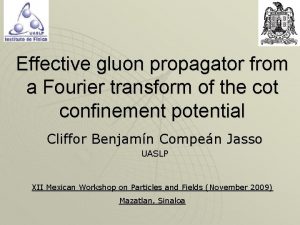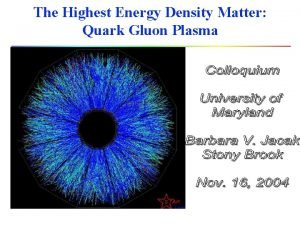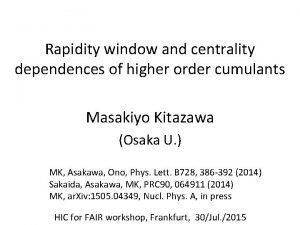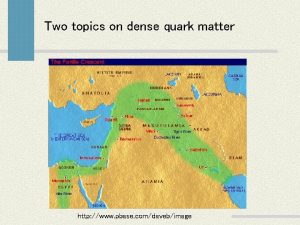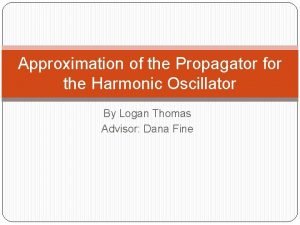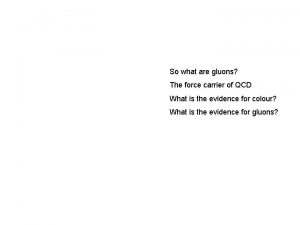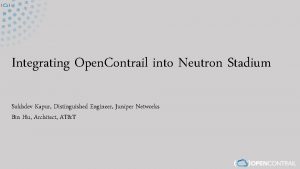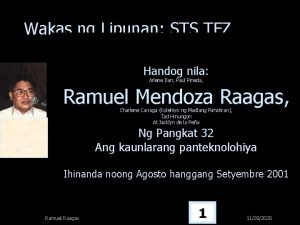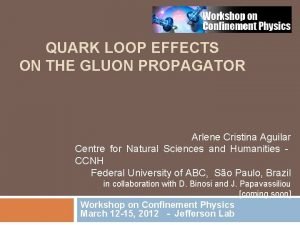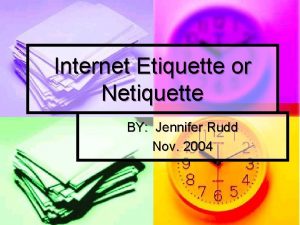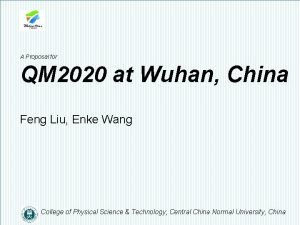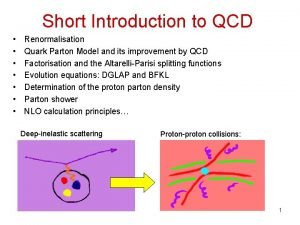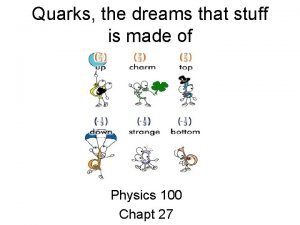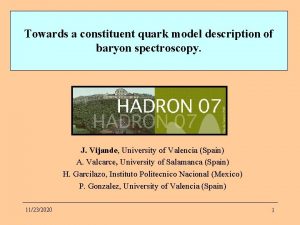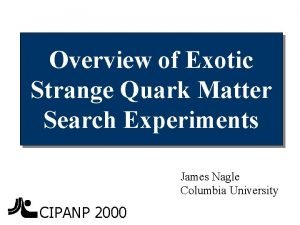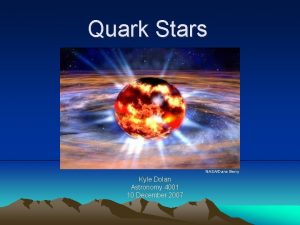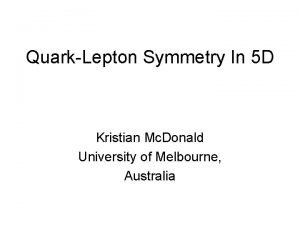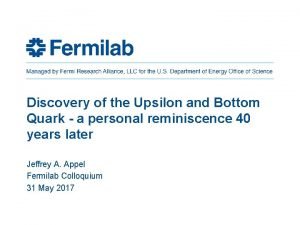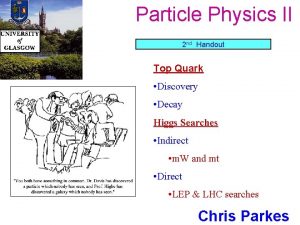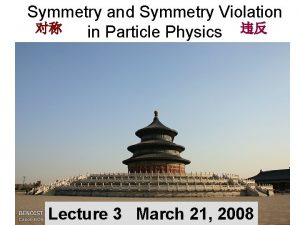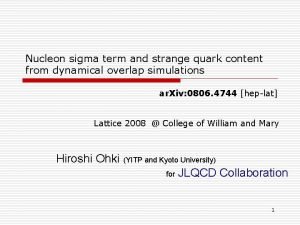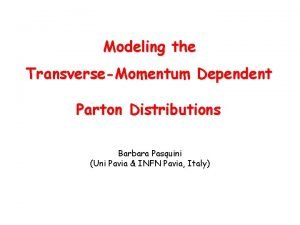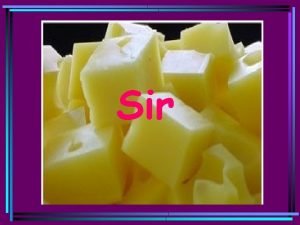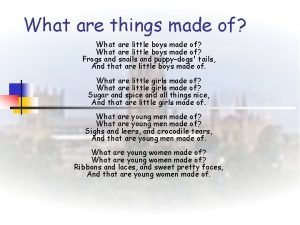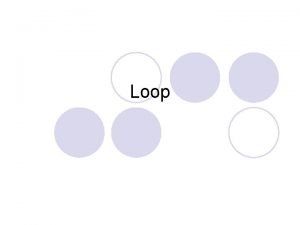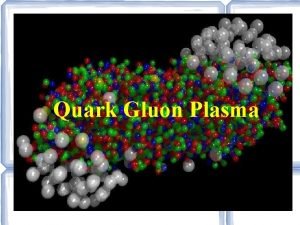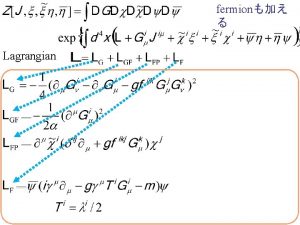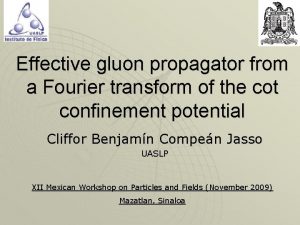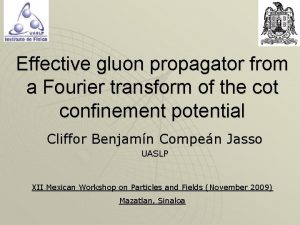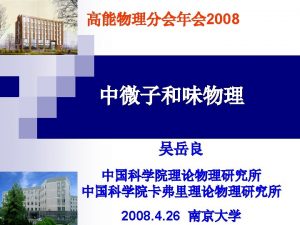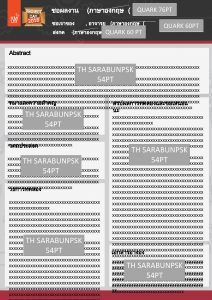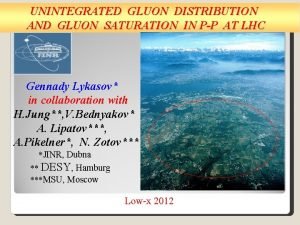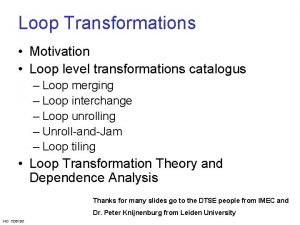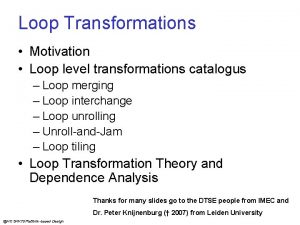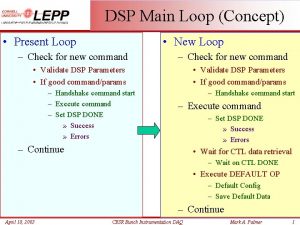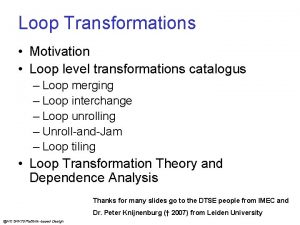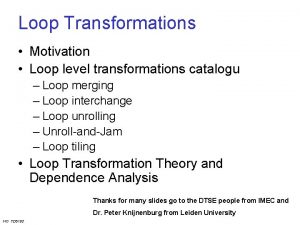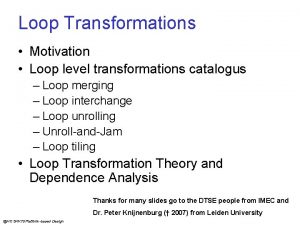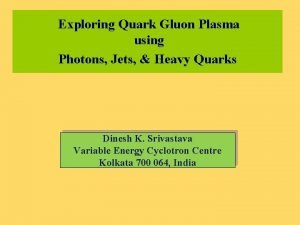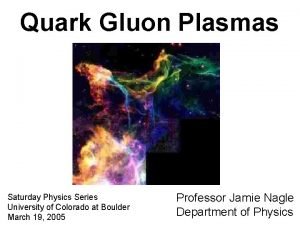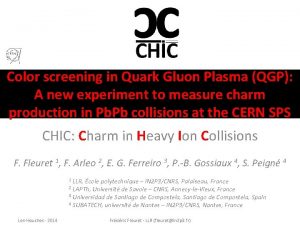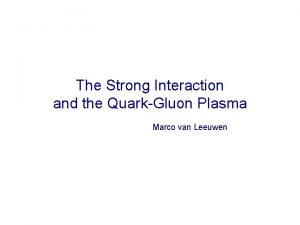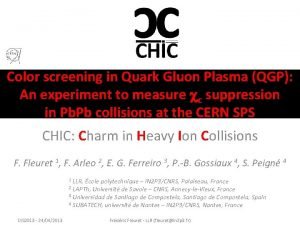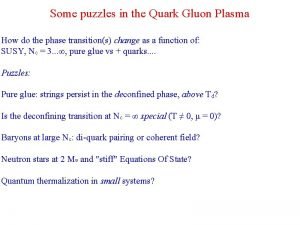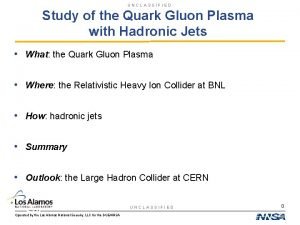QUARK LOOP EFFECTS ON THE GLUON PROPAGATOR Arlene




































- Slides: 36

QUARK LOOP EFFECTS ON THE GLUON PROPAGATOR Arlene Cristina Aguilar Centre for Natural Sciences and Humanities CCNH Federal University of ABC, São Paulo, Brazil in collaboration with D. Binosi and J. Papavassiliou [coming soon] Workshop on Confinement Physics March 12 -15, 2012 - Jefferson Lab

Outline of the talk Motivation Transversality of the PT-BFM gluon SDE and the inclusion of the quark loop The PT-BFM quark-gluon vertex and the nonperturbative calculation of the quark loop The impact of the quark loops on the gluon propagator shape Conclusions

Motivation In recent years, a substantial progress has been made in our understanding of various aspects of the nonperturbative dynamics of Yang-Mills theories, through the fruitful combination lattice and SDE. A significant part of the existing SD analysis has focused on the study of Green's functions at the level of a pure Yang-Mills theory, without the inclusion of quarks (majority of lattice simulations work in the quenched limit) Here we carry out a nonperturbative computation of the effects that the quark loops induce to the gluon propagator. Using as input the non-perturbative quark propagators obtained from the gap equation, and the fully-dressed quark-gluon vertex that satisfies the correct WI, and (ii) adding the resulting effect to the quenched gluon propagator obtained from the large-volume lattice simulations

The PT-BFM Schwinger Dyson series Transversality enforced loop-wise and field-wise because vertices satisfies: A. C. A and J. P, JHEP 0612, 012 (2006) A. C. A, D. B. and J. P. , Phys. Rev. D 78, 025010 (2008) D. B. and J. P. , Phys. Rev. D 77, 061702 (2008); JHEP 0811: 063, 2008, Phys. Rept. 479, 1 -152

Quenched gluon propagator Adding quarks to the gluon propagator Auxilary function conecting the conventional to the PT-BFM propagator Suffix Q indicates the effects of the presence of the quark loops

The nonlinear propagation of the presence of the quark in the other diagrams • Why • There will be a nonlinear propagation of the changes induced due to X(q), which will also affect the original subset of purely Yang-Mills graphs (a 1 –a 10) Internal gluon propagator and the three-gluon vertex gets modified. • We assume that the inclusion of two light quark flavors (m = 300 Me. V) may be considered as a “perturbation” to the quenched case. • Our operating assumption is that these effects may be relatively

The quark-gluon vertex • In the PT-BFM scheme, the contribution to the gluon self-energy due to the quark loop has a special ingredient: the fully-dressed quark-gluon vertex PT-BFM quark-gluon vertex • The PT-BFM quark-gluon vertex satisfies the Ward identity • Instead the conventional Slavnov-Taylor identity Quark propagator Quark-ghost scattering

The structure of the quark-gluon vertex • The most general Ansatz for the longitudinal part of • The form factor are where the functions A(p) and B(p) and the dynamical mass is defined as the ratio • The resulting vertex is known as Ball Chiu (BC) vertex J. S. Ball and T. W. Chiu, Phys. Rev. D 22, 2542 (1980

• Other possibility is the Curtis-Pennington (CP) vertex : Differs from the BC vertex by adding a tranversal piece (automatically conserved) - MR where D. C. Curtis and M. R. Pennington, Phys. Rev. D 42, 4165 (1990) • We will use both BC and CP vertices, and compare the difference they induce to the quantities of interest.

Nonperturbative calculation of the quark loop • The quark-loop of the PT-BFM scheme where df = ½ for SU(3) • Notice that the quark loop is transverse, i. e. • After inserting the BC vertex and taking the trace, we find

where the subindex “a” function evaluated at k and “b” at (k+q) • We find a term for each form factor Li of the BC vertex • In the limit of q 2 0 , we have

Contribution at zero momentum • It is important to notice that the integral vanishes by virtue of an identity valid in dimensional regularization know as “seagull identity” A. C. A and J. Papavassiliou, Phys. Rev. D 81, 034003 (2010). • Assuming that • We obtain The quark -loop has no direct influence on the value of (0) , its influence is through the nonlinear propagation • Notice that at one loop , A(k)=1 and M 2 (k) =m 2, this result was already expected!

• For the CP vertex, the answer will be expressed as a deviation from where is giving by the integral where • Notice that in the limit of • Therefore the result we have persists for the CP vertex.

Nonlinear propagation changes de value of the gluon • mass Let us cast the quenched gluon propagator (q 2) into the form When: q 2 0 Then q 2 J(q 2) 0 m 2 (0) 0 -1(0) 0 where J(q 2) is the “kinetic term”, or “wave function” contribution, whereas the m 2(q 2) is the momentum-dependent mass A. C. A. , D. Binosi and J. Papavassiliou, JHEP 1201, 050 (2012) In the presence of quarks , we have • Notice that m 2 (q 2) will change, despite the fact that X(q), does not contribute at q 2 = 0, since X(0) = 0. • X(q 2) does not affect directly the gluon mass equation; instead, the modification induced is indirect, due to the change in the overall shape of (q 2) throughout the entire range of momenta.

• Let us denote A reliable first-principle determination of 2 is not possible at the moment (we need to use the 2 -loop mass equation) • In the analysis presented here we will extract an approximate range for 2 , through extrapolation towards the deep IR of the curves obtained for intermediate momenta. • To estimate the effect of the quark loop(s) on the gluon propagator, we will suppose that the main bulk of correction comes from the extra diagram a 11. Therefore • Then

Renormalization • We will renormalize MOM scheme which the condition is given by where Euclidean version For large values of q 2 we obtain which is the correct one-loop result (in the Landau gauge).

Ingredients Use the relation A. C. A, D. Binosi, J. Papavassiliou and J. Rodri -Quintero, Phys. Rev. D 80 085018 (2009) I. L. Bogolubsky, et al , Po. S LAT 2007, 290 (2007)

Using quark SDE with the lattice gluon and ghost propagators and a nonabelian improved version of the BC e CP vertex, we have obtained A(k), B(k) and M(k) A. C. A and J. Papavassiliou, Phys. Rev. D 83, 014013 (2011)

^ X(q 2) ^ Results for the quark loop and XCP(q 2) Using BC vertex Using CP vertex Leading contribution comes from L 1 (quarkgluon vertex form factor)

Comparison ^ X(q 2) ^ and XCP(q 2)

Effects on the gluon propagator

Effects on the gluon propagator Due to the fact that X(0)=0 we obtain the freezing in the same point

Effects on the gluon propagator Cut the curve in the IR and extrapolate it. (Treat as a parameter )

Effects on the gluon propagator Cut the curve in the IR and extrapolate it As if was treated as a parameter

Effects on the gluon propagator Cut at 0. 02 Ge. V 2 - Q (0) = 6. 8 Ge. V-2

Effects on the gluon propagator Cut at 0. 05 Ge. V 2 - Q (0) = 6. 4 Ge. V-2

Effects on the gluon propagator Cut at 0. 07 Ge. V 2 - Q (0) = 6. 15 Ge. V-2 Variation around 10% at the value of Q (0) 2

Effects on the gluon propagator

Comparision of the unquenched gluon propagator with BC vertex

Comparision of the unquenched gluon propagator with BC and CP vertex

Comparision of the quenched and unquenched dressing gluon function

The effect of adding more quarks

Dependence on the renormalization point Small dependence the renormalization was carried out subtractively instead of multiplicatively.

The inclusion of loops containing heavier quark masses Heavy quarks Give rise to numerically suppressed contributions.

Conclusions We have studied the impact of the quark loop on the overall form of the gluon propagator. The conventional and the PT-BFM framework allowed us to single out gauge-invariantly the “one-loop dressed” quark loop diagrams. The difference is that in the PT-BFM the quark-gluon vertex appearing in the quark loop satisfies the WI instead of STI. We have used to models for the gluon-quark vertex: BC and CP vertex The presence of the quark loop suppress (by a nonlinear effect ) the IR freezing point of Q(q).

Comparison with the unquenched lattice
 Gluon propagator
Gluon propagator Quark gluon
Quark gluon Quark gluon plasma
Quark gluon plasma Quark gluon plasma
Quark gluon plasma Quark gluon
Quark gluon Harmonic oscillator propagator
Harmonic oscillator propagator Gluon force carrier
Gluon force carrier Gluon plugin
Gluon plugin Produkto ng pilipinas na iniluluwas sa ibang bansa
Produkto ng pilipinas na iniluluwas sa ibang bansa Miss arlene
Miss arlene Arlene gardner
Arlene gardner Arlene fajutrao dosen
Arlene fajutrao dosen Arlene cristina aguilar
Arlene cristina aguilar Arlene murphy
Arlene murphy Arlene hein
Arlene hein Arlene vetere
Arlene vetere Arlene barrett
Arlene barrett Arlene erlbach
Arlene erlbach Arlene wanted to increase the productivity
Arlene wanted to increase the productivity 10 internet etiquette
10 internet etiquette Arlene fern quien fue
Arlene fern quien fue Quark physics wordle
Quark physics wordle Quark matter 2022
Quark matter 2022 Quark parton model
Quark parton model Quark types
Quark types Constituent quark model
Constituent quark model Color quarks
Color quarks Quark astronomy
Quark astronomy Quark lepton symmetry
Quark lepton symmetry Quark names
Quark names Top quark decay
Top quark decay A charm quark has a charge of approximately
A charm quark has a charge of approximately Sigma quark composition
Sigma quark composition Quark model
Quark model Sirutka u prahu vindija
Sirutka u prahu vindija Quark names
Quark names Multi loop pid controller regolatore pid multi loop
Multi loop pid controller regolatore pid multi loop
